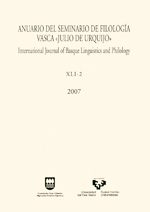How strong islands are derived from the way a top-down derivation is linearized
##plugins.themes.bootstrap3.article.main##
##plugins.themes.bootstrap3.article.sidebar##
Resumen
The goal of this paper is to show that strong islands can be derived from the way derivation is linearized, as long as we assume that the derivation proceeds in a topdown fashion.
To begin with, I will present one advantage of adopting a top-down approach regarding linearization issue: the Linear Correspondence Axiom (henceforth, LCA, Kayne 1994) can be reformulated in a more derivational and minimalist way. In particular, Kayne assumes that the notion that derives precedence is the asymmetric c-command. Because of the asymmetric c-command, the LCA rules out the head-complement configuration in bare phrase structures. I show that with a top-down derivation, the problematic asymmetric c-command relation can be eliminated. With our Top-down LCA, precedence relations are derived from the way phrase structures have been built: roughly, if Y enters the derivation right after X, then X precedes Y. In a second part, I will argue that this non-standard approach to derivation1 and linearization can capture CED effects: it will be demonstrated that subjects and adjuncts are islands because they have to be built in a parallel derivation.
Cómo citar
##plugins.themes.bootstrap3.article.details##
Esta obra está bajo una licencia Creative Commons Atribución-NoComercial-SinDerivadas 4.0 Internacional.


